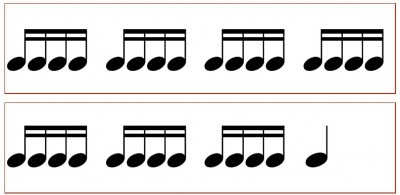One two three — five six seven
What’s the missing number?
If you said four, congratulations. You have a basic human ability to recognize patterns — one of the best tools we have to separate us from the monkeys and sea-slugs.
One of the simplest types of pattern is a rhythm, and the simplest rhythm is a steady cadence. Ba-dump, ba-dump, ba-dump. Imagine a metronome or a drummer tapping out a fixed, continuous pace at an unchanging rhythm.
This is also one of the most basic and useful tricks you’ll ever use when taking vitals!
See, measuring vitals involves feeling, hearing, or observing a series of fairly subtle blips over a period of time. Unfortunately, interference is common in the field, and it’s a rare day when bumps in the road and bangs in the cabin don’t eat up at least one of those blips.
When taking a radial pulse, if over 15 seconds you count 18 beats, you have a pulse of 72; but if just a couple of those beats are lost due to your movement or the patient’s, suddenly it becomes 64, which is a substantial difference. This is no good; we want better reliability than that.
Rhythm is the answer. A pulse is typically a regular rhythm. So are respirations. So are the Korotkoff sounds of a blood pressure. In order to establish this rhythm, you only need to hear two consecutive beats, and appreciate exactly how far apart they are. If you can do this, then you can continue to mentally tap out that pace — hopefully, while continuing to feel, see, or hear the true beats, which will help you to maintain the right speed, but even if you miss some, you’ll still have your mental beat to count. Even if you miss most of them!
So you feel for the pulse, and you palpate the first couple beats. Then you hit a tortuous section of road that throws you around the cabin, and you’re unable to feel anything for several seconds. But you already had the rhythm in your head, so when you pick up the pulse again, you haven’t lost the count — and you’ll end up with an accurate number.
Now, in sick people these rhythms aren’t always regular. And if you observe that a pulse or respiratory cycle isn’t regular, then this system won’t be as effective — for instance, there’s not much point in trying to find the “beat” to an A-Fib pulse. But small irregularities or breaks in the rhythm are okay, as long as there’s still a regular cycle underlying it; for instance, occasional dropped (or extra) beats won’t change the basic rate.
Give it a try. If you got rhythm, vital signs will never give you trouble again.

Just found your site, and it’s awesome!
This is something I’ve been doing since I started without even thinking because it makes life so much easier (but I also spent 10 years as a percussionist so it kinda came about naturally). It is merely a useful trick on the average person, but becomes priceless when he or she is uncooperative, restless, or a screaming kid.
I also use it with respirations, but those can be trickier because of the slow rate and need to identify an acceptable baseline interval. It is a great workaround, however, for the patient who won’t go without talking for more than 5 seconds, and sure beats just guessing.
I think my favorite aspect of this is that it minimizes the awkward silence that comes with checking vitals; that can be a real rapport killer. I love to quickly check a pulse and then ask an open ended question, while tapping out the rest of the rate during their response. I’m rather surprised I can’t remember anyone ever mentioning this before, so props to you on the creative post.